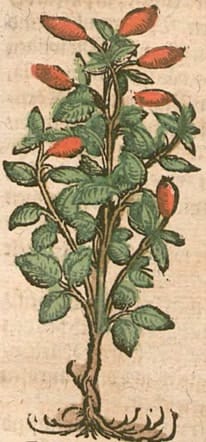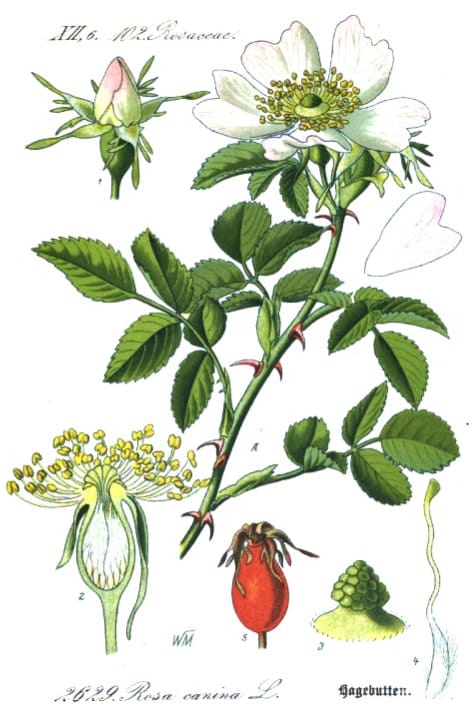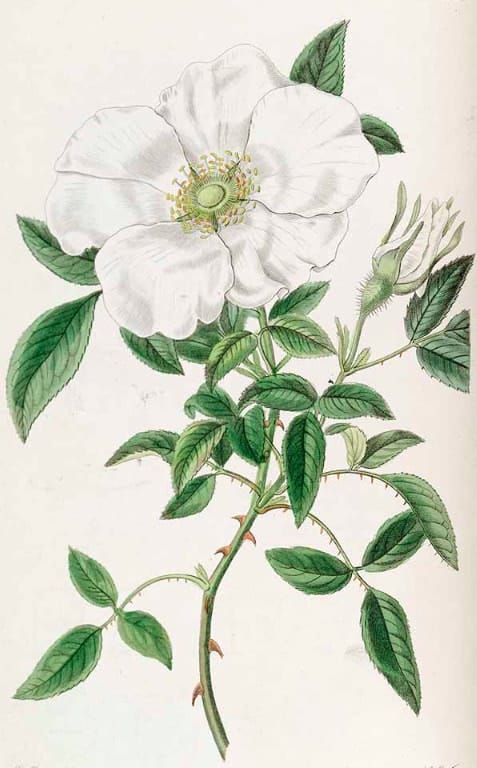Cynosbatus, Rose HipCherokee Rose Hip, Jin Ying Zi 金樱子CynosbatusCherokee Rose Hip, Jin Ying Zi 金樱子 (TCM) Se rgod སེ་རྒོད (Tibetan) |

|
 Krauterbuch, Lonitzer, 1578
Krauterbuch, Lonitzer, 1578 R. canina
R. caninaFlora von Deutschland (25), Kohler, 1886
 R. laevigata (Jin Ying Zi) used in TCM
R. laevigata (Jin Ying Zi) used in TCMEdwards’s Botanical Register, vol. 23, 1922
Botanical name:
Rosa canina
A number of different Rose species have supplied Rose hip traditionally including some cultivated varieties.
TCM uses the fruit of R. laevigata (Cherokee Rose, Jin Ying Zi)
In Tibetan Medicine, R. sertata, R. laevigata and R. davurica are used.
Parts used:
Fruit (Hips), with and without Seed
Temperature & Taste:
Neutral (slightly Cool). Sweet, sour, astringent
Uses:
1. Benefits the Kidneys, Promotes Urine (West, TCM):
–‘Strengthens the Weak and Feeble Kidneys’ (Gerard)
-Kidney and Bladder disorders with deficiency
-promotes Urine; Edema; Edema during Pregnancy
-Seminal Emission (TCM)
-Hips with Seed breaks Stones; Seeds are strongest
2. Astringes Yin and Essence, Strengthens the Bones (West, TCM):
-Lower back and joint pain, Osteoarthritis (especially the Conserve)
-conserve was highly regarded for Rheumatism
-Incontinence, Diabetes,
-poor Memory, Senility, disorders of old age, Menopause
-Anemia, Chronic illness, Convalescence
-Chronic Diarrhea or Dysentery
3. Clears Heat, Resists Poison:
-beginning of Cold, Flu, Sinusitis
-helps prevent infection during Epidemics
-Fever, Eruptive Fevers, Thirst of Fevers
-Swollen Lymph nodes, Scrofula
4. Benefits the Heart, promotes Circulation (West):
-absent, scanty or painful Menstruation
-Heart weakness and poor circulation, especially in the elderly
-“Long-term use makes one feel happy and vigorous and able to withstand cold weather” (Shu Ben Cao)
5. Stops Nausea and Vomiting:
-Conserve is good for Nausea, Vomiting and Diarrhea (West)
Dose:
Decoction: 6–12 grams in Decoction (up to 30 grams when used alone);
Powder: 1–3 grams
Preparation:
Cherokee Rose hip (Jin Ying Zi) is usually used in its raw, dried form, but is sometimes prepared in TCM:
1. Stir-fried Rosehip with Honey,
it is sweet and astringent. This can strengthen the Stomach and Spleen while also being astringent, and is therefore used for Diarrhea associated with Spleen deficiency.
2. Salt prepared Rosehip:
Steeped in salt water, then steamed, and dried in the sun, it is stronger to enter the Kidneys, preserve the Essence, and stop Spermatorrhea and Leukorrhea.
3. Rosehip Paste:
Stew the fresh Rosehips, then press through a sieve to obtain a paste of them. This is taken with wine as a tonic.
Comment:
1. The Chinese and Western use of Rose hip can be considered synonymous. As can be seen from the above illustrations the appearance of both varieties is very similar, as is their pharmacology.
2. Chinese commentaries noted that Rose hip only astringes, but does not tonify. Therefore, in the treatment of deficiency, it must be combined with Tonics. The Western use of the Conserve of Rose hip possesses mild tonic properties.
3. Rich in Vitamin C, the dried pulp containing up to 8%.
Main Combinations:
1. Cold, Flu:
i. Rose hip with Elder flower, Thyme, Sage
ii. Rose hip with Camomile, Balm, Sage
iii. Rose hip with Elder flower, Balm, Ribwort Plantain
2. Sinusitis, Rose hip with Elder flower, Camomile, Sage
3. Allergic Rhinitis, Rose hip seed, Eyebright, Nettle
4. Eruptive Fevers:
i. Rose hip with Balm, Camomile, Linden flower
ii. Measles, Rose hip with Elder flower, Linden flower
5. As an astringent, Conserve of Rose hip with Syrup of Poppy.
6. Spermatorrhea:
i. Rose hip (Jin Ying Zi) with Lotus seed (TCM)
ii. Rose hip (Jin Ying Zi) with Cuscuta seed Tu Si Zi (TCM)
7. Hernia, Rose hip with Comfrey, Fennel seed
8. Chronic Diarrhea:
i. combined Rose hip Conserve with Red Coral, Catechu, Cinnamon
ii. combine Rose hip (Jin Ying Zi) with Atractylodes Bai Zhu, Codonopsis Dang Shen
9. Scrofula, Lymphadenitis:
i. Rose hip with Sponge ashes and Juniper
ii. Rose hip with Madder, Walnut leaf (Nouveau Formulaire Medicale et Pharmaceutique, 1820)
iii. Sponge, Rose hip (2 oz. each), burn to ashes. To every ounce of the ashes add: Cinnamon (half oz.), Burnt Pepper (2 drams), Red Coral (1 and a ½ drams), Mix. (Niemann)
10. To strengthen Heart and Circulation
i. Rose hip with Balm, Rosemary
ii. Rose hip with Rosemary, Hawthorn, Motherwort, Calendula
11. Anemia Rose hip with Nettle and Wormwood
12. To promote Urine:
i. Difficult Urination, Rose hip with Juniper berry, Parsley seed, Horsetail, Restharrow
ii. obstructed Urine, Rose hip with Pellitory of the Wall, Juniper, Carrot seed, Fennel seed, Marshmallow, Raisins (Fuller)
iii. Rose hip with Golden Rod, Horsetail, Myrtle leaf, Dead Nettle
13. Urinary Tract Infection, Rose hip with Horsetail, Dandelion, Peppermint
14. Rheumatoid Arthritis, Rose hip with Agrimony, Nettle, Birch leaf, Celery seed
15. Hemoptysis, Conserve of Rose hip (4 oz.), Syrup of Pomegranate (2 drams), Syrup of Poppy (1 dram), Potassium nitrate (2 scruples). Mix. Dose: 1 teaspoonful every 2 or 3 hours. (Nouveau Formulaire Medicale et Pharmaceutique, 1820)
16. Tonic for the elderly Rose hip with Raspberry leaf
17. To tonify Essence, Rosehip and Fox nuts (Euryale Qian Shi), equal parts. Powder and make pills.
18. Restless or irritable children, Rose hip with Camomile, Balm, St. Johns wort
Cautions:
Generally Safe.
Not used for acute Diarrhea from Heat and Damp.
Main Preparations used:
Candied Fruit; Conserve of Rose hip
1. Conserve of Rosehips:
i. Pulp of Rose hips (1 lb.), White Sugar powder (20 oz.). Beat together. (London)
ii. fresh Rose hips, seeds and hairs removed (1 part), White Sugar (3 parts). Reduce the fruit to a pulp, add the Sugar and beat well together. (Edinborough)
iii. Pulp of Rose hips, White Sugar (equal parts). Evaporate slowly to the proper consistency. (Pharmacopoeia medici practici universalis, Bruxelles, 1817)
